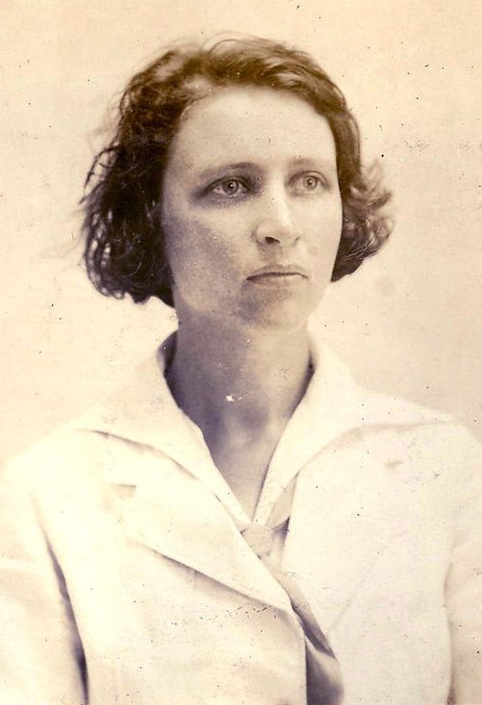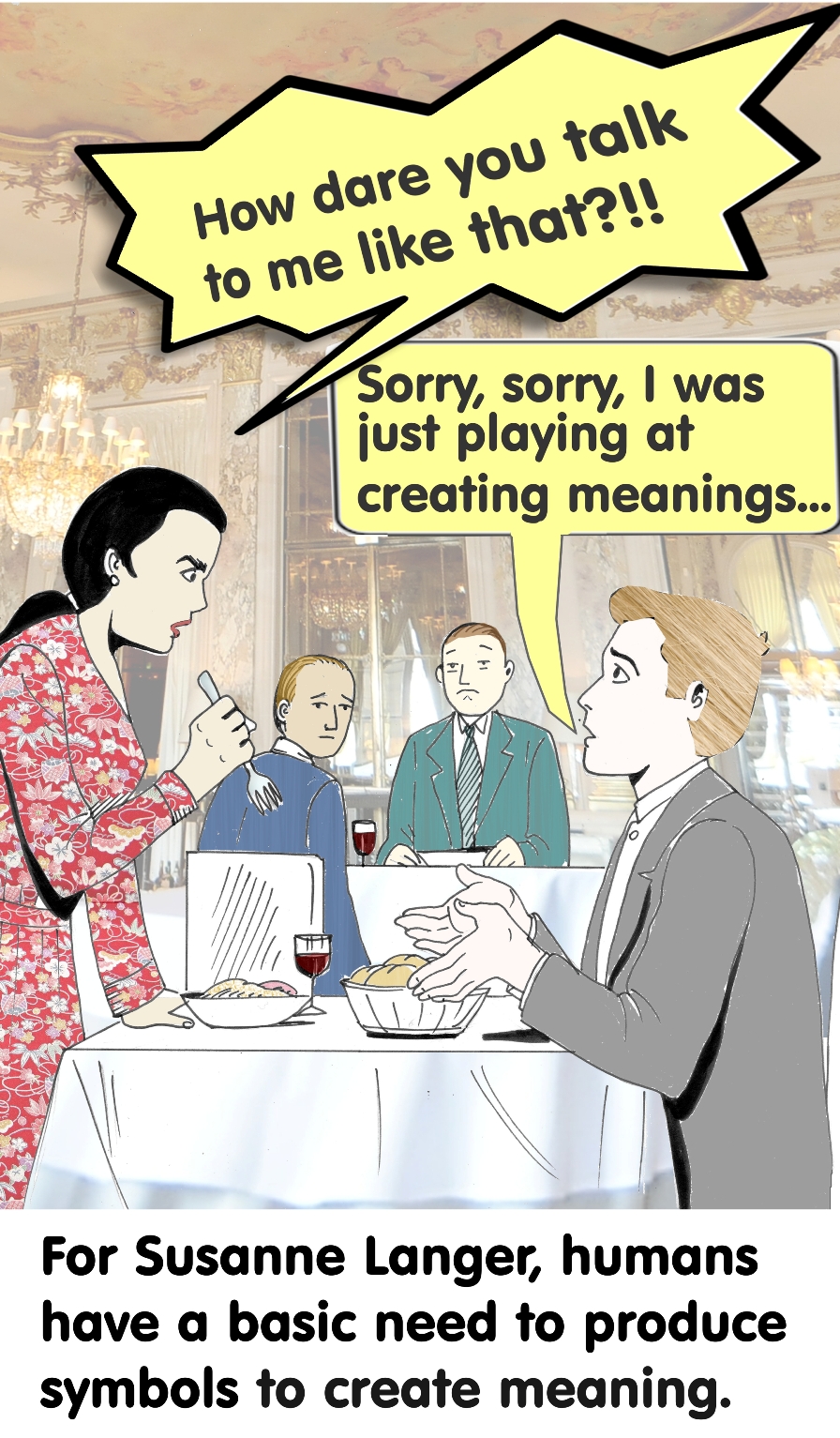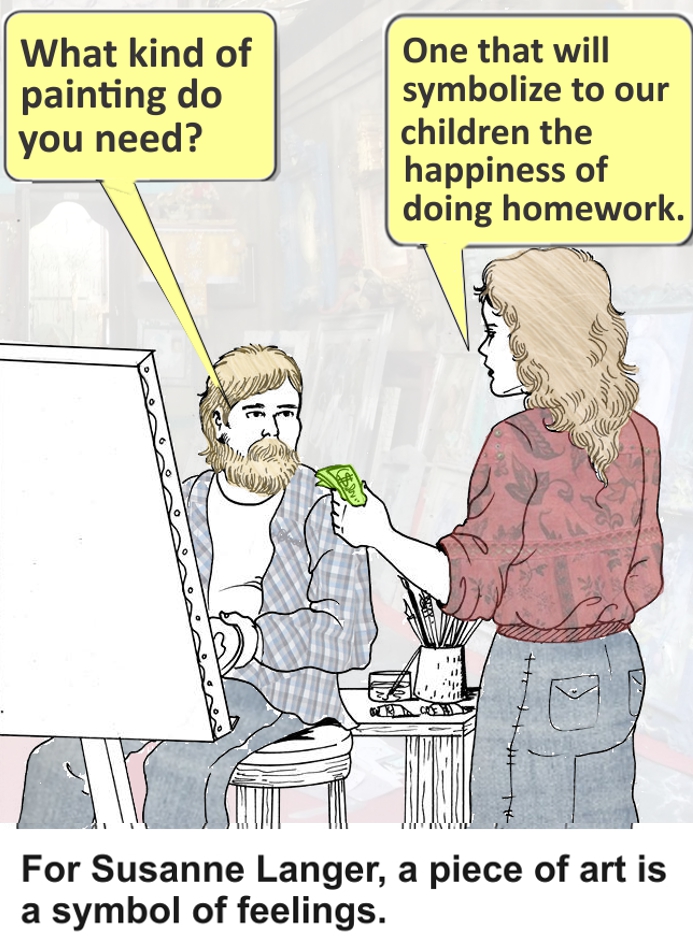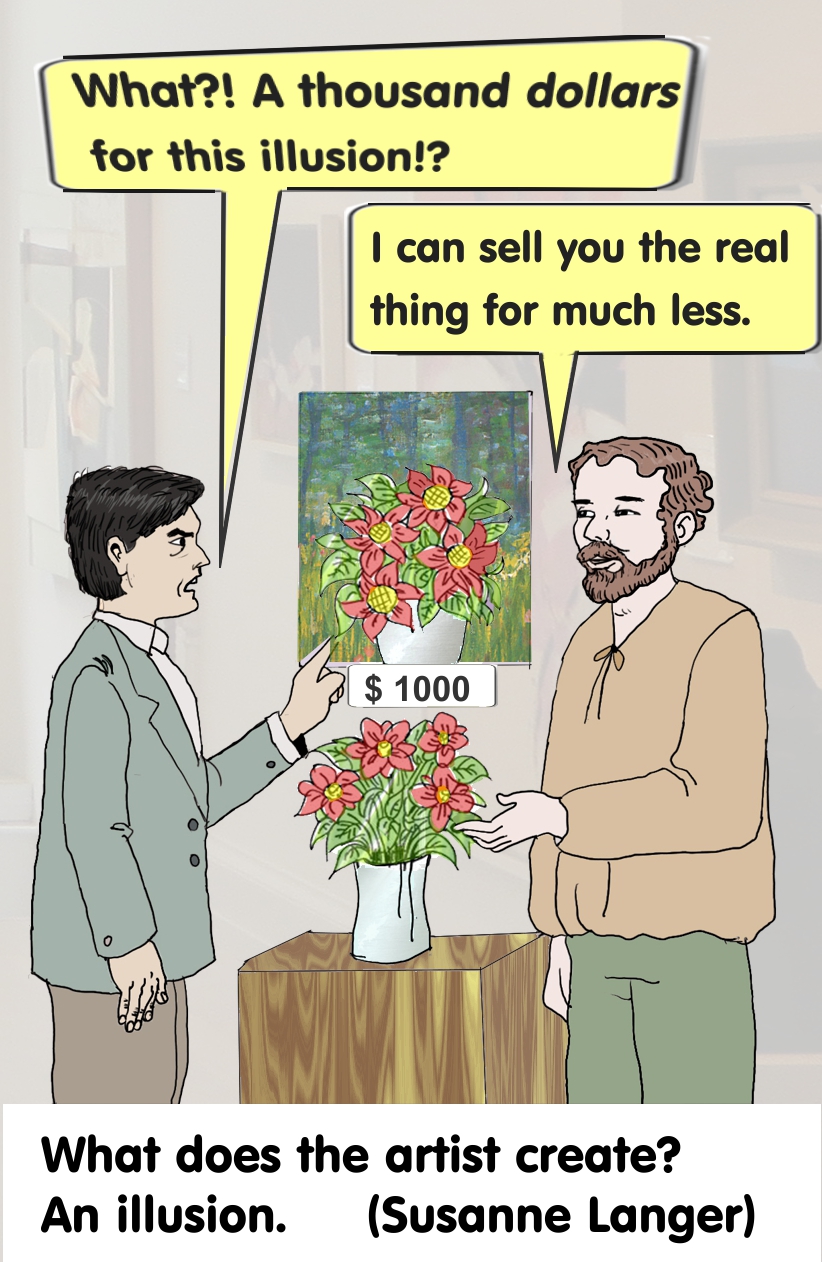LIST OF PHILOSOPHERS
THEMES ON THIS PAGE:
| 1. THE NEED TO SYMBOLIZE | 2. ART SHAPES FEELINGS | 3. ART AS AN ILLUSION |
 Susanne Langer (1895-1985) was an American Philosopher, one of the first female academic philosophers in the USA, popular in the past but nowadays often neglected or forgotten. She was born in New York to German-born parents and grew up speaking German. She first attended Radcliffe (a women’s college which was parallel to Harvard all-male college), where she studied under the British philosopher Alfred Whitehead, who influenced her thought, and she was also influenced by Ernst Cassirer’s philosophy of symbolism. She received her PhD degree in philosophy from Harvard, where she met her future husband, and the two had two boys before divorcing. After receiving her doctorate degree, Langer taught philosophy at several American colleges and universities. She spent her last years writing until she became almost blind. She died at her home in Connecticut at the age of 89.
Susanne Langer (1895-1985) was an American Philosopher, one of the first female academic philosophers in the USA, popular in the past but nowadays often neglected or forgotten. She was born in New York to German-born parents and grew up speaking German. She first attended Radcliffe (a women’s college which was parallel to Harvard all-male college), where she studied under the British philosopher Alfred Whitehead, who influenced her thought, and she was also influenced by Ernst Cassirer’s philosophy of symbolism. She received her PhD degree in philosophy from Harvard, where she met her future husband, and the two had two boys before divorcing. After receiving her doctorate degree, Langer taught philosophy at several American colleges and universities. She spent her last years writing until she became almost blind. She died at her home in Connecticut at the age of 89.
Langer’s work focused primarily on symbols as they function in language, art, and the human mind. She was especially interested in how humans use symbols to create meaning, with a special emphasis on philosophy of art. She argued that although art cannot be analyzed in a rational way, art is not just an expression of blind feelings. Rather, it involves symbols which cannot be translated into logical formulation.
|
TOPIC 1. THE NEED TO SYMBOLIZE |
 Langer’s best-known book is Philosophy in a New Key (1942), which was popular at the time. In this book she argues that philosophy needs to receive a new life, before the old philosophy gets tired and sterile. This requires a new set of basic concepts which would generate fresh new issues and discussions. The new “key” for philosophy, she suggests, is symbolism, through which humans create meaning. Philosophy’s new role will be to explore the structure and function of symbols in human life. As she says in Chapter 1 (slightly adapted):
Langer’s best-known book is Philosophy in a New Key (1942), which was popular at the time. In this book she argues that philosophy needs to receive a new life, before the old philosophy gets tired and sterile. This requires a new set of basic concepts which would generate fresh new issues and discussions. The new “key” for philosophy, she suggests, is symbolism, through which humans create meaning. Philosophy’s new role will be to explore the structure and function of symbols in human life. As she says in Chapter 1 (slightly adapted):
The end of a philosophical epoch comes when the concepts that move it are exhausted. […] In the fundamental notion of symbolization – mystical, practical, or mathematical, it makes no difference – we have the keynote of all humanistic problems. In it lies a new conception of "mentality" that may illumine questions of life and consciousness […] Perhaps it holds the seed of a new intellectual harvest, to be reaped in the next season of the human understanding.
It is important to note that for Langer, human symbols include not only “discursive symbols” which operate in everyday language and science, but also non-discursive symbols which cannot be analyzed or even described. These include “presentational symbols” – an important concept in Langer’s philosophy which refers to meaning-giving activities such as music, art, myth and ritual.
The following text is taken from Chapter 2 of this book (adapted for ease of reading), where she argues that humans use symbols not just for practical reasons – for communication, food, etc. – but out of a unique human need to create and express meaning.
This basic need, which certainly is obvious only in man, is the need of symbolization. The symbol-making function is one of man's primary activities, like eating, looking, or moving about. It is the fundamental process of his mind, and goes on all the time. […] Symbolization is the essential act of mind, and the mind contains more than what is commonly called “thought.” Only certain products of the symbol-making brain can be used according to discursive reasoning. In every mind there is an enormous store of other symbolic material, which is put to different uses or perhaps even to no use at all— it is a mere result of spontaneous brain activity, a reserve fund of conceptions, a surplus of mental wealth.
[…] The material supplied by the senses is constantly shaped into symbols, which are our elementary ideas. Some of these ideas can be combined and manipulated in the manner we call "reasoning." Other ideas do not give themselves to this use, but are naturally telescoped into dreams, or evaporated into conscious fantasy. And a vast number of ideas build the most typical and fundamental structure of the human mind—religion. Symbolization is pre-rationative, but not pre-rational. It is the starting point of all intellection in the human sense, and is more general than thinking, imagining, or acting.
[…]
The fact that the human brain is constantly producing symbolic transformation of experiential data makes it a fountain of more or less spontaneous ideas. Since all experience tends to terminate in action, it is natural that a mental function that is typically human would produce an external activity that is typical human. And that is exactly what we find in the sheer expression of ideas. This is the activity which animals do not seem to have a need for. And it accounts for precisely those human characteristics which are not shared with other animals—ritual, art, laughter, crying, speech, superstition, and scientific genius. Only a part of our behavior – although a very important part – is practical. […] The rest serve simply to express ideas that the organism yearns to express, i.e. to act upon, without practical purpose, without trying to satisfy any need other than the need to complete in external action the brain's symbolic process.
How else shall we explain man's love of talking? From the first moment that a child recognizes that words can express something, talking is a dominant interest, an irresistible desire. As soon as this avenue of action opens, a whole stream of symbolic process is set free in the jumbled flow of words – often repeated, disconnected, random words – that we observe in the "chattering" stage of early childhood.
[…] But in fact, speech is the natural outcome of only one kind of symbolic process. There are transformations of experience in the human mind that have quite different behavioral endings. They end in acts that are neither practical nor communicative, although they may be both effective and communal, I mean the actions which we call ritual. Human life is full of ritual, as it is also with animal-like practices. It is a complex fabric of reason and ritual, of knowledge and religion, prose and poetry, fact and dream. Just as the results of that primitive process of mental digestion, verbal symbolism, may be used for the satisfaction of other needs than symbolization, so all other instinctive acts may serve the expressive function. Eating, traveling, asking or answering questions, construction, destruction, prostitution – any or all such activities may enter into ritual. Yet, ritual in itself is not practical, but expressive. Ritual, like art, is essentially the active termination of a symbolic transformation of experience. It is born in the cortex, not in the primitive brain, but it is born from a basic need of that organ, once it has become a human organ.
If the "non-practical" use of language has confused philosophers and psychologists who measured it according to foreign standards, the apparent perversity of ritual has simply overcome them. They had to invent excuses for its existence. […] The answer is, of course, that ritual is not done for a practical purpose, not even that of social solidarity. Such solidarity may be one of its results, and sophisticated leaders may realize this fact and use it by emphasizing national religion, or by holding compulsory prayers before battle, but neither myth nor ritual arose originally for this purpose.
|
TOPIC 2. ART SHAPES OUR “LIFE OF FEELING” |
 Susanne Langer devoted much of her writings to art. For her, a work of art is a symbol, in the sense that it takes us to a certain meaning, or an idea. Thus, a poem is a symbol, a painting is a symbol, a symphony is a symbol. Each work of art as a whole is a symbol, and its meaning cannot be analyzed into smaller elements. To understand the work, you must look at it as a whole.
Susanne Langer devoted much of her writings to art. For her, a work of art is a symbol, in the sense that it takes us to a certain meaning, or an idea. Thus, a poem is a symbol, a painting is a symbol, a symphony is a symbol. Each work of art as a whole is a symbol, and its meaning cannot be analyzed into smaller elements. To understand the work, you must look at it as a whole.
A symbol of what? A symbol of feelings. More precisely, a piece of art symbolizes (or represents) an organic whole of feelings, or what Langer calls “life of feeling,” or a “subjective unity of experience.” Music, for example, may be a symbol of the flow of tensions and relaxations which we experience in life.
Notice that Langer is not saying that a work of art AROUSES feelings or EXPRESSES feelings, but rather that it is a SYMBOL OF feelings, or a REPRESENTATION OF feelings: “…what art expresses is not actual feeling, but ideas of feeling; just as language does not express actual things and events but ideas of them” (Chapter 4). Furthermore, art not only symbolizes our life of feeling, it also shapes it. Art and art education are therefore education of our feelings.
The following text is taken from Langer’s book Feeling and Form: A theory of art (1953). Some of the sentences have been simplified for ease of reading.
From CHAPTER 20: EXPRESSIVENESS
A work of art is a single, indivisible symbol, although a highly articulated one. It is not like a conversation, which is a composite that can be analyzed into more elementary symbols – sentences, clauses, phrases, words […] An art-work may indeed be analyzed in the sense that various elements can be distinguished in it, but it can never be reconstructed by a process of combining its elements, because these elements do not exist outside the art-work. They only occur in the totality.
[…] Pure sensation – now pain, now pleasure – have no unity, and they change the person’s sensitivity only in simple ways. What is important in human life is sensations that are interpreted and shaped: remembered and anticipated, feared or wanted, or even imagined and avoided. Perception shaped by imagination gives us the external world we know. And the continuity of thought systematizes our emotional reactions into attitudes with distinct feeling-qualities, and determines the scope of an individual’s emotions. In other words: thanks to our thought and imagination we have not only feelings, but a LIFE OF FEELING.
This life of feeling is a stream of tensions and resolutions. Probably all emotions, all feeling-qualities, moods, and even personal “sense of life” or “sense of identity” are a complex interplay of tensions. […] The symbolic power of music comes from the fact that music creates a pattern of tensions and resolutions. Since its substance is in virtual time, the pattern of musical tensions is temporal. But in the plastic arts we find the same sort of pattern in a non-temporal form. The abstraction produced by the symbol is probably not greater there, but it is more evident. Painting, sculpture, architecture, and all similar arts do the same thing as music.
[…] The artist does not have to experience in actual life every emotion he can express. By manipulating the elements he created, he may discover new possibilities of feelings, strange moods, perhaps concentrations of passion that are greater than his own temperament could ever produce. Because although a work of art reveals the character of subjectivity, it is itself objective. Its purpose is to objectify the life of feeling.
[…] The meaning of an art symbol cannot be built up from elements like the meaning of a conversation, but must be first seen as a whole. In other words, the “understanding” of a work of art begins with an intuition of the whole presented feeling. Contemplation then gradually reveals the complexities of the work, and of its meaning. In linguistic discourse, meaning is understood through a sequence of understandings; but in art, the complex whole is seen first. This creates a real epistemological problem: artistic meaning, unlike verbal meaning, can only be presented – but not explained – to anyone to whom the art symbol is not clear. Since there are no semantic units with given meanings which could be expressed by symbols (as words can be defined or translated), there is no way to figure out the meaning of an art-work. The only way to communicate the feeling-content of a drawing, a melody, a poem, or any other art symbol, is to present it so abstractly and powerfully that anyone with normal sensitivity for this art will see its “emotional quality.”
From CHAPTER 21: THE WORK AND ITS PUBLIC
Above all, art penetrates deep into personal life because by giving shape to the world, it articulates human nature: sensibility, energy, passion, and mortality. The arts, more than anything else in experience, shape our actual life of feeling. […] Surely, art originates in experience; but experience is built up in memory and shaped in imagination according to the intuitions of powerful artists who are often long dead. […] Artistic training is, therefore, the education of feeling […] Few people realize that the real education of emotion is not “conditioning” through social approval and disapproval, but the tacit, personal, illuminating contact with symbols of feeling.
|
TOPIC 3. ART AS AN ILLUSION |
 The following text is adapted from Langer’s lecture “Creation,” which appeared in her book PROBLEMS OF ART (1957). The book contains ten lectures on philosophy of art, which were given to different audiences over several years. In the lecture below, Langer asks: What does the artist create? Her answer is: an illusion (which she also calls an apparition, in other words something ghost-like, a mere appearance). This may be clear in the case of a painter, who creates an illusory flower, or an illusory room or landscape. But what kind of illusion does music create? Langer’s response is: an illusion of “felt time,” or “lived time” – not objective physical time, but the time which we experience in our movements, in our thoughts and feelings, in our life.
The following text is adapted from Langer’s lecture “Creation,” which appeared in her book PROBLEMS OF ART (1957). The book contains ten lectures on philosophy of art, which were given to different audiences over several years. In the lecture below, Langer asks: What does the artist create? Her answer is: an illusion (which she also calls an apparition, in other words something ghost-like, a mere appearance). This may be clear in the case of a painter, who creates an illusory flower, or an illusory room or landscape. But what kind of illusion does music create? Langer’s response is: an illusion of “felt time,” or “lived time” – not objective physical time, but the time which we experience in our movements, in our thoughts and feelings, in our life.
It is customary to speak about an artist's work as "creation." A painter "creates" a painting, a dancer "creates" a dance, a poet "creates" a poem. If he falls and gets nothing done, he will probably worry about not being "creative." But when a factory worker – in a candy or fabric factory, for example – has a sore throat and stays away from work, he is not called "uncreative.” In fact, he may spend the day at home playing piano – which doesn't produce any material object at all – and then he will be said to be creating music. Why? Why is a piece of music a creation and a shoe usually just a product?
[…] The difference between creation and other productive work is this: An ordinary object, such as a shoe, is made by putting pieces of leather together. The pieces were there before. The shoe is a construction of leather. It has a special shape and use and name, but it is still an object made of leather, and that is how we think of it. A picture is made by putting pigments on a piece of canvas, but the picture is not a pigment-and-canvas structure. The picture that emerges from the process is a structure of space, and the space itself is a whole made of shapes, visible colored volumes. Neither the space nor the things in it were in the room before. Pigments and canvas are not in the pictorial space; they are in the space of the room, as they were before. […]
The virtual space of a painting is created. The canvas existed before, the pigments existed before, they have only been moved about, arranged to compose a new physical object which the painter calls "my big canvas" or "that little new canvas." But the picture, the spatial illusion, is new in the sense that it never existed before, anywhere, nor did any of its parts. The illusion of space is created.
[…]
Illusion is the "stuff" of art, the "stuff" out of which the expressive form is made. To call the art-image illusory is simply to say that it is not material; it is not cloth and paint-stains, but space organized by balanced shapes with dynamic relations, tensions and resolutions. Actual space is not like that; it has no organic form, like pictorial space.
[…]
Music, too, presents us with an obvious illusion, which is so strong that although it is obvious, it is sometimes unrecognized because it is regarded as a real physical phenomenon: This is the appearance of movement. Music flows; a melody moves; a succession of tones is heard as a progression. The differences between tones that follow each other are steps, or jumps, or slides. Harmonies arise, and they shift, and move to resolutions. A complete section of a sonata is quite naturally called a "movement." […] We hear marching, flowing, or driving progressive motion. Yet in a musical progression there is nothing that is displaced, that goes from somewhere to somewhere else. Musical movement is illusory, like volumes in pictorial space.
Through this purely apparent movement, music presents an auditory apparition of time; more precisely, what one might call "felt time." Instead of sensing time vaguely as we usually do through our own physical life-processes, we hear its passage. But this passage is not a simple one-dimensional trickle of successive moments, as it is in classical physics and practical life. Musical time is not at all like clock-time. It is wide and complex and variable in a way that makes it utterly unlike metric time. This is because our usual experience of time is the passage of our vital functions and lived events, felt inwardly as tensions – somatic, emotional, and mental tensions, which have a characteristic pattern.
[…]
The principle of creation is the same in all the arts, even if what is created differs from one art to another. Every work of art is wholly a creation. It is not a mixture of illusory and actual elements. Materials are actual, but art-elements are always virtual. And it is these elements that an artist composes into an apparition, an expressive form.
When you subscribe to the blog, we will send you an e-mail when there are new updates on the site so you wouldn't miss them.
